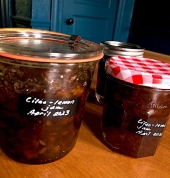
 8
8




find religion! church
kiva! hyvä! iloinen! pikkumaatila
get stung! beehives
be hospitable! host-a-hive
be antisocial! facespace




Invasive plants are Earth's way of insisting we notice her medicines. Stephen Herrod Buhner
Everyone learns what works by learning what doesn't work. Stephen Herrod Buhner
 2
2




 4
4




tel jetson wrote:
I can think of at least one alternative way to solve my problem without the brazing pan. simmering un-puréed quince in a little water with the sugar already added instead of simmering after it’s already puréed would likely work in one of the smaller and deeper pots I already had.

 5
5




Megan Palmer wrote:
How do you mostly use your quinces?
find religion! church
kiva! hyvä! iloinen! pikkumaatila
get stung! beehives
be hospitable! host-a-hive
be antisocial! facespace

|
Opportunity is missed by most people because it is dressed in overalls and looks like work - Edison. Tiny ad:
The new kickstarter is now live!
https://www.kickstarter.com/projects/paulwheaton/garden-cards
|




